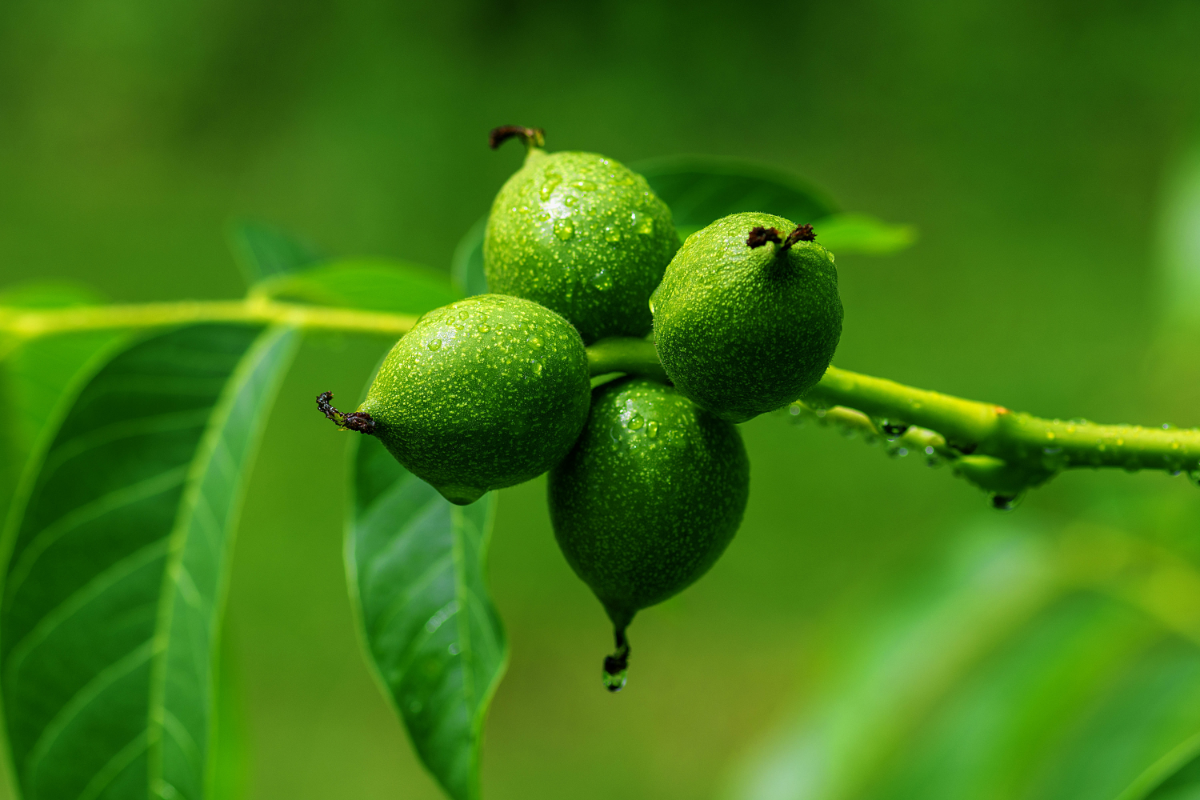A number of plant species can be used to accompany your autumn cure. Among them, walnut (Juglans Regia) deserves special attention. First of all, because of the seasonal effect, in keeping with the rhythm of nature.
What are the characteristics of walnut?
The walnut is a majestic tree that is sensitive to cold, stagnant air and damp. It is a solitary tree; the juglone (a quinone produced by the leaves and roots of the tree) prevents the germination of other species around it. We can draw an analogy with the energy of autumn that we have been talking about, which pushes us into a form of withdrawal and solitude that encourages introspection. Similarly, how many of us are sensitive to the damp, stagnant autumn air, and approach this transitional season with a sense of distance?
Finally, we should remember that Dr Bach recommended the use of Walnut to accompany transitions and to respond to a need for protection from the outside world. Another parallel with the season?
Botanical description
Walnut trees grow to a height of 20 to 25 metres, or even 30 metres in a stand. They reach the end of their growth cycle after 60 to 80 years. These deciduous trees live up to 150 to 160 years in Western and Central Europe. Their bark, which is light grey and thin when young, cracks deeply with age. Their deciduous, alternate, imperipinnate leaves give off an aromatic scent when crumpled. They consist of 5 to 9 oval leaflets.
Walnut trees are monoecious. Their male flowers appear in greenish hanging catkins. Female flowers appear later in pairs at the tips of the branches. Pollination is by wind. The fruit are green drupes with a woody shell inside. The term ” walnut” refers either to the whole fruit, the fruit without the green shell, or the kernels. Walnuts ripen in autumn.
Black walnut trees can live for between 200 and 300 years, while common walnut trees live for between 300 and 400 years. Their trunks can exceed 1.50 m in diameter. The common walnut reaches a height of 25m, compared with 40m for the black walnut in its native range. Walnut leaves smell of walnut stain. Male and female flowers coexist on the same tree. The husk surrounding the fruit is green in common walnut and yellow in black walnut.
Black walnut and hybrid walnut trees grow faster than common walnut. They are all light species, tolerating a certain amount of shade. Grown for their fruit and precious wood, they are native to Eastern Europe and temperate Asia. They flower in April-May and bear fruit in September-October.
Distribution
The walnut tree in all its forms
Walnuts are rich in fibre, magnesium and antioxidants, including vitamin E. A handful of walnuts every day is a great way to benefit from this cocktail.
The oil
Walnut oil is a real treat at this time of year, to accompany salads and seasonal vegetables. You’ll benefit from its positive effects on the nervous system and digestive tract, as long as you choose organic, first cold-pressed oil, and keep a close eye on storage (it oxidises very quickly!).
Walnut oil is golden to light brown in colour, with a pronounced flavour reminiscent of bread crust and biscuit. Mainly used to season salads and vegetables, this oil is delicate due to its high unsaturated fatty acid content. It is not suitable for cooking at high temperatures, but can be used to flavour hot dishes at the end of cooking. For optimum preservation, it should be stored away from air and light, and refrigerated after opening.
Composed mainly of triacylglycerols and unsaturated fatty acids, walnut oil has a high concentration of polyunsaturated fatty acids (PUFAs), with a predominance of linoleic acid (omega-6) and alpha-linolenic acid (omega-3). Omega-6 and omega-3, known for their cholesterol-lowering and anti-inflammatory effects, contribute to blood fluidity and vasodilation. The balance between these two types of fatty acid is essential, with walnut oil offering a near-ideal omega-6/omega-3 ratio (4.71), in contrast to common dietary imbalances.
Walnut oil also contains monounsaturated (omega-9) and saturated fatty acids, but in smaller quantities. Its richness in vitamin E and phenolic compounds gives it antioxidant properties, although these are less pronounced than in walnut kernels due to the extraction process. The quality of the oil varies according to the extraction method used, with first cold-pressed virgin oils generally being richer in bioactive components.
Phytotherapy
In phytotherapy, Walnut is found in various forms(glycerol macerate, capsules, EPS, etc.). While the highly astringent hull is used to combat intestinal parasites, the leaves and buds regulate blood sugar levels, digestive problems and skin disorders.
Gemmotherapy
In gemmotherapy, the Walnut bud has a particularly surprising action in the plant world, as it stimulates intestinal flora. Coupled with its depurative and astringent action, it responds perfectly to the season’s need to drain and purify while nourishing saprophytic flora.
Thanks to its action on the digestive system, Walnut bud macerate has a knock-on effect on the skin (as the intestine transfers waste it is unable to evacuate to the skin) and on the respiratory system (the lungs also take over from an overworked intestine).
Walnut bud macerate, known for its regulating effects on saprophytic flora, is effective against a variety of health problems. In dermatology, it is indicated for treating abscesses, acne, skin allergies, dermatitis, eczema, boils, impetigo, mycosis, psoriasis and warts. For the digestive system, it relieves gastric acidity, aerophagia, bloating, cirrhosis, diarrhoea, dysentery and pancreatitis. It is also used to regulate metabolism in cases such as diabetes and poisoning.
For the blood and lymphatic system, it helps in the treatment of varicose ulcers, anaemia, arteritis and haemorrhoids. It is beneficial for the urogenital system in cases of cystitis, urinary tract infection and urethritis. It also supports the immune and respiratory systems in conditions such as allergies, bronchitis, herpes, immune weakness, sinusitis and tracheitis. Finally, it is useful for osteoarticular disorders, such as osteoarthritis and chronic progressive polyarthritis.
This macerate is an effective digestive system regenerator, restoring intestinal flora and acting positively on the pancreas and spleen. It is particularly recommended for diarrhoea, acne and diabetes. Its bioactive components give it antioxidant, detoxifying, immunostimulant and neuroprotective properties.
Bach Flower Remedies
Bach Walnut Flower Essence is designed to help free oneself from past influences and protect oneself from external influences, particularly during periods of transition. It comes from Juglans regia, more commonly known as common walnut, Persian walnut or royal walnut. The Common Walnut, of uncertain origin, is common in France. It can be recognised by its large deciduous leaves. Its trunk cracks as it ages. Its flowers appear in summer. They consist of elongated male catkins. The female flowers form smaller groups.
People who benefit from Walnut generally have specific ambitions. They may be influenced by external factors. These factors include dominant personalities, family constraints or attachments to the past. Walnut is useful for therapists and counsellors. It helps with emotionally demanding clients. It offers protection and stability against external influences.
Walnut’s positive potential manifests itself in the determination to achieve one’s goals. It allows you to remain free to carry out your plans. Despite the obstacles, criticism or discouragement of others.
What are the benefits of Walnut?
Walnut is a treasure trove of essential nutrients, making it an excellent natural remedy for maintaining good health in autumn. Its health benefits are many and varied, but here are some of the main ones:
Rich in antioxidants
Walnuts, the fruit of the walnut tree, are rich in antioxidants. These include polyphenols, carotenoids and vitamin E. These compounds protect our bodies from free radicals. These unstable molecules can damage cells. The antioxidants in walnuts neutralise these free radicals. As a result, they reduce the risk of chronic diseases. These include heart disease, cancer and age-related disorders.
Strengthens the immune system
Autumn is a good time for respiratory infections, but walnuts can help strengthen our immune system. Walnuts are a valuable source of vitamin C, which plays an essential role in maintaining a strong immune system. Vitamin C stimulates the production of immune cells, strengthens the body’s defence barriers and helps fight infection. What’s more, walnuts also contain zinc, a mineral vital for optimal immune function. Zinc promotes the multiplication of immune cells and improves their ability to fight pathogens.
Promotes good heart health
Taking care of our heart is essential, and walnuts can play a beneficial role in preserving our heart health. Walnuts are rich in unsaturated fatty acids, such as monounsaturated and polyunsaturated fatty acids, which are beneficial to our cardiovascular system. These healthy fatty acids help to reduce LDL cholesterol levels (bad cholesterol) and increase HDL cholesterol levels (good cholesterol), thereby helping to maintain a healthy lipid balance. What’s more, walnuts contain antioxidants and anti-inflammatory compounds that promote healthy blood vessels, reduce inflammation and protect against heart disease.
Improves brain health
Brain health is crucial to our overall well-being, and walnuts can play a role in keeping it at its optimum level. Walnuts are an excellent source of omega-3 fatty acids, essential fats for brain function. These fatty acids help build the brain’s cell membranes and promote the transmission of nerve signals. By eating walnuts regularly, we can improve our concentration, memory and cognition. What’s more, the omega-3 fatty acids found in walnuts have been linked to a reduced risk of neurodegenerative diseases such as Alzheimer’s and dementia.
FAQ
Q : Does walnut have anti-inflammatory properties?
Yes, walnut contains anti-inflammatory compounds such as omega-3 fatty acids and antioxidants. These substances can help reduce inflammation in the body and relieve the symptoms associated with certain inflammatory diseases.
Q : Can walnut help maintain good cholesterol levels?
A : Walnut contains a lot of unsaturated fatty acids. These include polyunsaturated and monounsaturated fatty acids. They help maintain healthy cholesterol levels. Studies show that eating walnuts regularly reduces LDL (bad) cholesterol. They also increase HDL (good) cholesterol.
Q : Do walnuts have beneficial effects on cardiovascular health?
Yes, walnut is associated with numerous cardiovascular health benefits. The unsaturated fatty acids found in walnuts can help reduce the risk of cardiovascular disease by improving blood vessel health, reducing inflammation and promoting better heart function.
Q: Can eating nuts help prevent type 2 diabetes?
Q : Can walnut help to improve brain health?
Yes, walnuts are considered to be beneficial for brain health. The omega-3 fatty acids found in walnuts are essential for brain development and function. They can help improve memory and concentration and reduce the risk of neurodegenerative diseases such as Alzheimer’s.







